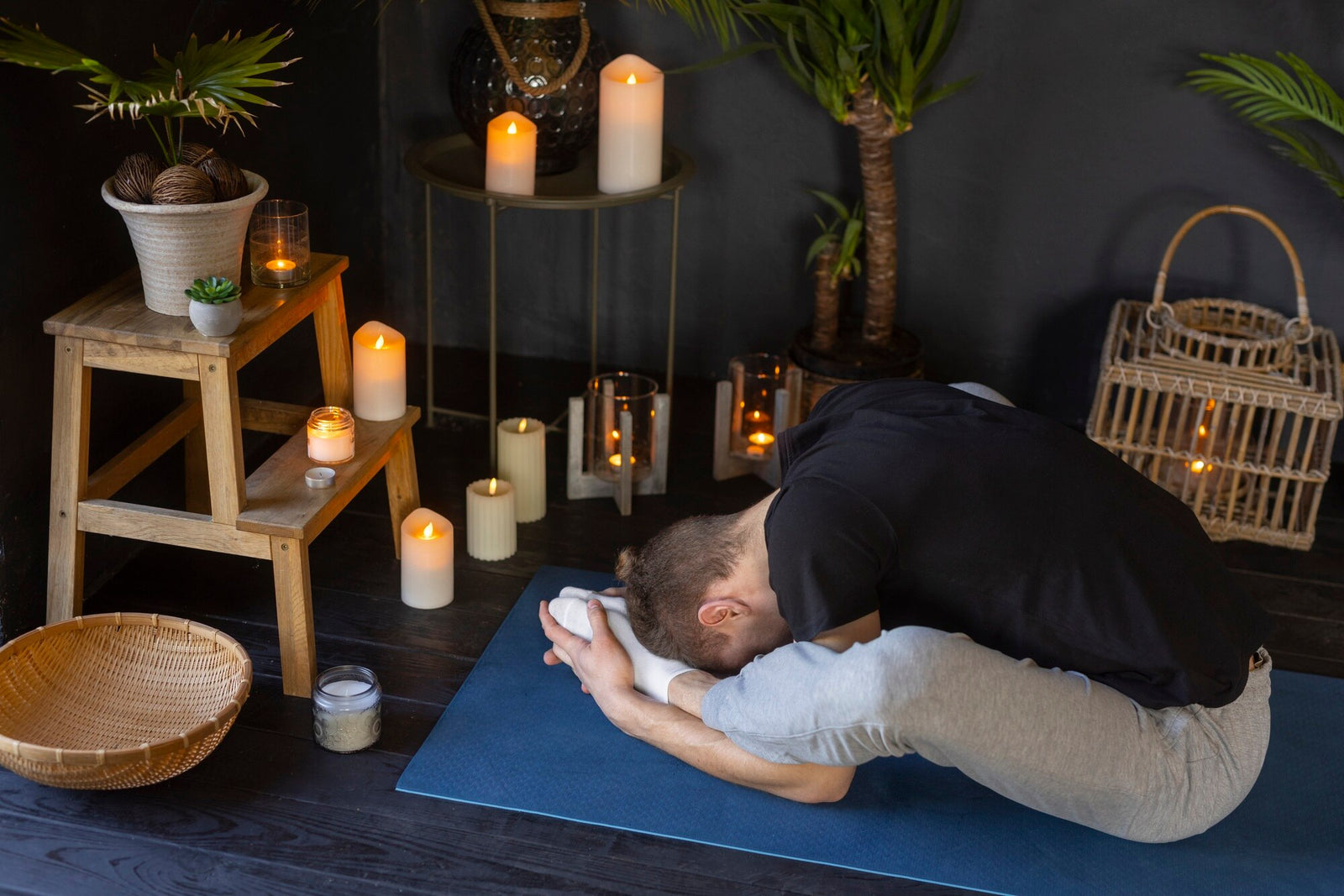Why Should You Meditate? The Power of Candlelight Meditation

In today's fast-paced world, finding a moment of peace and stillness can feel like an impossible task. Yet, more than ever, it's crucial to carve out time for ourselves to unwind and reconnect. This is where meditation comes into play. It's an age-old practice that offers a plethora of mental, emotional, and physical benefits. But why should you meditate? And how long should you dedicate to this practice? Let's explore these questions and uncover the unique advantages of candlelight meditation.
Key Takeaways
- Benefits of Meditation
- Importance of Meditation Duration
- Importance of Consistency in Meditation Practice
- Candlelight meditation can improve mental well-being by reducing stress and anxiety.
- The Physical Health Benefits of Candlelight Meditation.
- Candlelight meditation can help explore spiritual benefits and connect with the inner self.
- Integrating candlelight meditation into your daily routine is as simple as finding a quiet space and setting a regular time.
- Types of Meditation Techniques.
- Personal experiences and success stories.
Why Should You Meditate?
Practicing meditation offers numerous benefits. Being used to meditation helps reduce stress and anxiety and promotes overall mental health. Studies suggest it improves focus and concentration. Regular meditation can lower blood pressure and enhance heart health. It also boosts emotional resilience and self-awareness. Many find that it fosters a sense of inner peace. Additionally, meditation may improve sleep quality and increase energy levels. Engaging in this practice regularly can lead to a more balanced and fulfilling life.
Meditation isn't just a trendy buzzword; it's a powerful tool for enhancing overall well-being. Here are some compelling reasons to incorporate meditation into your daily routine:
Mental Benefits
- Reduces Stress: One of the most extensively studied and well-documented benefits of meditation is its ability to relieve stress. By focusing on the present moment and calming the mind, meditation can significantly lower cortisol levels, the hormone associated with stress.
- Enhances Focus and Concentration: Regular meditation practice can improve your attention span and cognitive functions. It trains the brain to maintain better focus and resist distractions.
- Boosts Creativity and Problem-Solving Skills: Meditation encourages a state of relaxed awareness, allowing the mind to quiet down and focus. This state can lead to enhanced creativity, as it opens up new pathways for thinking and innovation. Additionally, it can improve problem-solving abilities by fostering a calm and clear mindset, enabling more thoughtful and practical solutions.
Emotional Benefits
- Promotes Emotional Health: Meditation increases self-awareness and positivity by encouraging focus on the present moment and mindfulness, which helps individuals better understand their thoughts and emotions. It can help manage symptoms of depression and anxiety by fostering a sense of inner peace and reducing stress levels. Regular meditation practice can also improve concentration, enhance emotional health, and even lower blood pressure, making it a valuable tool for overall well-being.
- Improves Relationships: By fostering empathy and compassion, meditation can significantly improve your relationships with others. It encourages mindfulness in communication, allowing you to be more present and attentive when interacting with family, friends, and colleagues. Additionally, meditation helps you respond thoughtfully instead of reacting impulsively in emotional situations, leading to more constructive and harmonious interactions. Through regular practice, your ability to understand and connect with others deepens, enhancing both personal and professional relationships.
Physical Benefits
- Enhances Sleep Quality: Regular meditation can help in managing sleep patterns, resulting in a more profound and restful sleep. By promoting relaxation and diminishing stress, meditation prepares the mind and body for better sleep. It can calm racing thoughts and reduce anxiety, and as a result, you can fall asleep quickly and stay asleep through the night. Consistent meditation practice can improve overall sleep quality and contribute to better health.
- Boosts Immune System: Research shows that meditation can strengthen your immune system, reducing your chances of getting sick. Regular meditation helps reduce stress, improves mental clarity, and enhances overall well-being, all of which strengthen your immune response.
- Reduces Pain: Studies show that regular meditation can change brain activity, making it easier to manage discomfort. Mindfulness meditation can help reduce pain by altering the way your brain handles pain signals. This practice involves focusing on the present moment without judgment, which enables you to handle pain differently.
How Long Should You Meditate?
Proper meditation duration can amplify benefits. Short sessions offer relaxation, but extended periods yield more profound results. Consistency in timing ensures mental clarity and emotional balance. Experts often recommend at least 20 minutes for noticeable impact. Longer sessions help in reaching advanced states of mindfulness. They also promote better stress management and self-awareness. However, even five-minute intervals can be beneficial. It's crucial to start with manageable duration and gradually increase.
The ideal duration for meditation can vary depending on your personal goals and experience level. However, the key is not necessarily the length of time spent meditating but the consistency of your practice.
Beginners
- Start Small: If you're new to meditation, start with just 5-10 minutes a day. Find a quiet place where you can meditate without being interrupted, sit comfortably, and concentrate on your breathing. This can help you build a habit without feeling overwhelmed. Gradually, as you become more accustomed to the practice, you can increase the duration and explore different meditation techniques.
- Focus on Consistency: Aim to meditate at the same time each day to establish a routine. Consistency helps reinforce the habit, making it easier to integrate meditation into your daily schedule and reap its long-term benefits.
Intermediate and Advanced Practitioners
- Increase Gradually: Once you feel comfortable with shorter sessions, gradually increase the duration to 20-30 minutes. Start by adding a few extra minutes each week to build up your endurance. This continuous approach will help your body adapt to the increased activity level, reducing the risk of injury and enhancing your overall performance.
- Experiment with Longer Sessions: For those with more experience, longer sessions of 45 minutes to an hour can offer deeper insights and more significant benefits. These extended times let you explore complex topics more positively and absorb more information, leading to better understanding and skill in the subject.
Importance of Consistency in Meditation Practice
Consistency is crucial in meditation. Regular practice helps the mind and body adapt to the calming effects more effectively. Daily sessions, even if they are short, create a habit. This habit strengthens focus and reduces stress over time. Skipping sessions can hinder progress and diminish benefits. A consistent routine also makes it easier to reach deeper states of relaxation and mindfulness. Sticking to a regular schedule enhances overall well-being and maximizes the benefits of meditation.
The Power of Candlelight Meditation
Candlelight meditation adds an extra dimension of calm and focus to the practice. The gentle flickering flame serves as a focal point, helps quiet the mind, and deepens the experience. As you gaze at the flame, the soft, rhythmic movement can draw you into a state of serenity, making it easier to let go of distracting thoughts. The warm glow also creates a soothing atmosphere and enhances the overall sense of relaxation. Here's why candlelight meditation is particularly compelling:
- Calming Effects: The soft glow of candlelight creates a tranquil atmosphere that's perfect for relaxation. It casts gentle shadows that dance on the walls, adding a serene touch to any space. The flickering light can signal to your brain that it's time to slow down, unwind, and enter a meditative state. Combined with a soothing scent, candles can transform your environment into a peaceful retreat, a sanctuary from the stresses of daily life, where you can find solace and calm.
- Enhanced Focus: By focusing on the flame, you can prevent your mind from wandering. This visual anchor makes it easier to concentrate, especially if you find it hard to control your thoughts. By watching the gentle flicker of the flame, you create a focal point that engages your senses. The warmth and glow can also bring a sense of calm and peace, helping you stay present and mindful. This technique is helpful during meditation or when you need a quiet moment during a busy day, allowing you to control your thoughts and emotions.
Personal Experience
In my experience, candlelight meditation brings a unique sense of peace and clarity. When you light a candle and keep watching the flame it will help you feel calm and focused. The soft glow creates a peaceful atmosphere that helps calm the mind. The flickering flame draws your attention away from distractions, allowing for more profound relaxation. This practice enhances mindfulness and fosters a deeper connection with oneself.
The Science Behind Candlelight Meditation
Research has shown that candlelight meditation can have a profound impact on the brain. When individuals engage in this practice, they enter a state of deep relaxation that is characterized by changes in brain wave activity. Specifically, candlelight meditation increases alpha brain waves, which are connected with a relaxed and alert state of mind that helps you feel relaxed and alert. This can reduce stress and anxiety, improve focus and concentration, and boost overall mental well-being. Focusing on the flame quiets the mind and promotes mindfulness, which is linked to better mental health.
Practical Tips for Candlelight Meditation
Starting a candlelight meditation journey is simpler than you might imagine. Begin with just a few minutes each day, extend the duration slowly day by day as you need to become more comfortable with the process. Note, every small step of this process counts towards a more relaxed and stress-free you.
Ready to give candlelight meditation a try? Here are some tips to help you get started:
Create the Right Setting
- Choose a Quiet Space: Find a comfortable, quiet place where you won't be disturbed, such as a cozy corner of your home or a serene spot in nature. Make sure the surroundings are tranquil, allowing you to focus and relax without any interruptions.
- Dim the Lights: Lower the lighting in the room to enhance the candle's glow, creating a warm and cozy ambiance that will highlight the flickering flame and create a peaceful atmosphere.
- Select a Comfortable Seat: Sit cross-legged on a cushion or in a chair with your feet flat on the floor, ensuring your back is straight and shoulders relaxed. If using a chair, keep your knees at a 90-degree angle and your hands resting comfortably on your thighs.
Avoid Distractions
- Turn Off Electronics: Ensure your phone and other devices are turned off or set to do not disturb to avoid interruptions during essential meetings or focused work sessions. This will help you stay concentrated and maintain productivity.
- Set a Timer: Use a gentle alarm to signal the end of your session so you don't have to keep checking the time. This way, you can stay fully immersed in your activities without the distraction of constantly monitoring the clock, allowing for a more productive and enjoyable experience.
Maintain Focus
- Use a Steady Gaze: Gaze softly at the candle flame, keeping your eyes relaxed and unfocused. Notice the gentle flickering of the light, allowing your mind to calm as you take in the warm, soothing glow. Breathe slowly and deeply, letting the peaceful ambiance envelop you.
- Breathe Deeply: Breathe slowly and deeply to calm your mind and body. Inhale through your nose, fill your lungs, and then exhale slowly through your mouth. This will help reduce stress and help you relax.
- Acknowledge Distracting Thoughts: If your mind starts to wander, gently refocus on the flame, letting its steady glow anchor your thoughts. Take a deep breath, and let the warmth and light guide you back to a state of calm and concentration.
Why You Should Give Candlelight Meditation a Try
Many people who have practiced candlelight meditation in their daily lives noticed significant improvements in their mental, physical, and spiritual well-being. For example, some have found that this practice helped them reduce stress and anxiety, improve focus and concentration, and enhance their overall mood. Others have reported experiencing a greater sense of inner peace and contentment, as well as a deeper connection to their spirituality. Overall, personal testimonials and success stories suggest that candlelight meditation can be a powerful tool for promoting holistic well-being.
Types of Meditation Techniques
Different meditation techniques meet different needs. Mindfulness meditation focuses on being present. Loving-kindness meditation promotes compassion. Body scan meditation involves mentally scanning each part of the body. Transcendental meditation uses a mantra for focus. Guided meditation consists of following a narrator. Zen meditation emphasizes posture and breath. Yoga Nidra brings deep relaxation. Each technique offers unique benefits. Individuals should explore and find what resonates best with them. Experimenting can lead to discovering the proper personal practice.
Choosing the Right Meditation Technique for You
When it comes to choosing the proper meditation technique, your personal preference and goals should be your guiding lights. You have the freedom to experiment with various methods like mindfulness, loving-kindness, or transcendental meditation. It's crucial to listen to your body and mind during practice and to assess which technique brings you the most comfort and focus. Seeking guidance from experienced practitioners can provide valuable insights, but remember, the ultimate decision should be based on what promotes relaxation and inner peace for you.
Conclusion
Candlelight meditation offers a serene and focused experience that can enhance the benefits of traditional meditation practices. Creating a calming atmosphere and providing a visual anchor can help you achieve a deeper state of relaxation and mindfulness. Whether you're experienced or new to meditation, I encourage you to give candlelight meditation a try. Set aside a few minutes each day, light a candle, and embark on a journey of personal growth, discovering the tranquility and clarity that this simple practice can bring.


